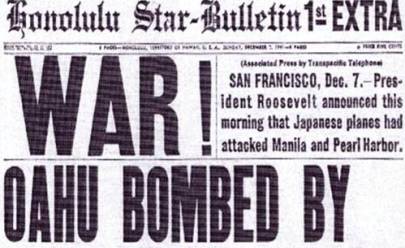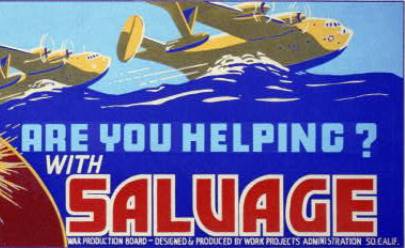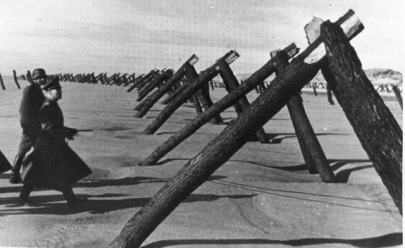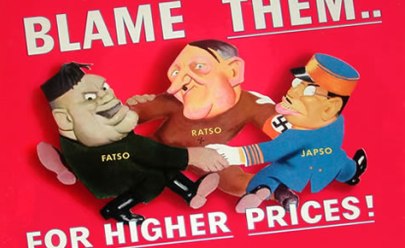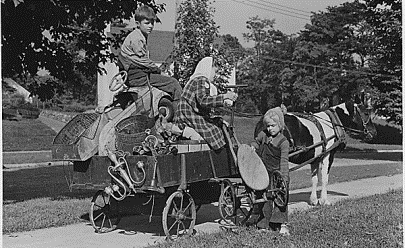WWII OVERVIEW:
War Clouds
The generation of Americans who came to adulthood during the 1930s grew up in a world shadowed by extraordinary economic and military threats.
A financial depression gripped much of the globe, throwing millions out of work. In some countries, economic hardship contributed to the power and appeal of political extremists. These leaders offered simple solutions to their countries' problems, solutions that included extreme nationalism, military expansion, and doctrines of racial superiority.
In Germany, Adolf Hitler created a fascist state that threatened the peace of Europe. Hitler renounced treaty obligations, began a rapid arms buildup, and made territorial demands on Germany's neighbors. He and the Italian dictator Benito Mussolini joined their nations in a military union.
In Asia, another militarized state expanded its borders. Early in the 1930s Japan, hungry for land and raw materials, seized Manchuria. Soon it set its sights on further expansion in China and Southeast Asia.
Separated by two oceans from these troubles, Americans hoped to isolate themselves from war. Yet at the end of this troubled decade their lives were profoundly altered by events that unfolded far from home.
The Late 1930s: Imbalance of Power
The world of the 1930s was one of extremes.
In Japan, Germany, and Italy, violently nationalistic leaders were at work building formidable war machines. They used their military power to threaten other countries. Threats soon gave way to hostilities, and the people of Europe and Asia lived increasingly in the shadow of hatred and oppression.
A far different attitude towards war existed in the United States. Situated between Europe and Asia, America had a small peacetime army and a deep unwillingness to be drawn into another global conflict. Americans were content in their isolation. Many were coping with the harsh realities of the Depression. Few wanted to get involved in troubles overseas.
But it was impossible to ignore events taking place around the world. Some Americans harbored growing concerns that these events could pose a threat to the United States. Still, isolationist sentiment remained strong. Bowing to popular pressure, President Franklin D. Roosevelt signed the Neutrality Acts, which kept the country in a passive position.
Meanwhile, the German, Japanese, and Italian armed forces continued to grow. By 1939 it was clear that the United States was at a grave military disadvantage. Should it be drawn into war, it would face a difficult situation.
Germany's Expansion
During the 1930s Germany and Japan expanded their armed forces with astonishing speed, through conscription and massive production programs. Military expenditures skyrocketed, especially in Germany. By 1939 the armies and air forces of both countries dwarfed those of the United States. Even Italy, whose army was only a fraction of the size of Germany's and Japan's, had more troops than the United States. America's only strength was its navy, which served, with the Atlantic and Pacific Oceans, as the nation's main line of defense.
Japan
At the start of the 1930s Japan was an overcrowded nation heavily dependent on foreign imports of food and raw materials. In 1931 ultranationalists pushed the country to seize the Chinese province of Manchuria. As the decade progressed, the military increasingly dominated Japan's economy and government. The army grew enormously and the navy boasted aircraft carriers, powerful battleships, and strong air and submarine forces. In 1937 Japan entered a full-scale war with China. But American and British presence in the region hindered Japan's ambitions in Southeast Asia. War production accelerated in anticipation of future conflicts.
United States
After World War I the United States returned to its traditional policy of isolation from armed conflicts abroad. America's military was reduced drastically. During the 1920s and 1930s its strength remained low. Even as war loomed in Europe and Asia, America made little effort to mobilize. In 1939 the United States armed forces ranked 18th in the world. The nation was far from being a military superpower. Only the navy, which had long been America's primary line of defense, was maintained at a level that commanded respect.
Germany
After its defeat in World War I, Germany was forced to demilitarize. The Treaty of Versailles restricted Germany to an army of 100,000 men and forbid it to have a navy or air force. Until the early 1930s Germans were preoccupied with reviving their crippled economy. But in 1935 Adolf Hitler, in a bid to build a new German empire, began remilitarization--in direct violation of the Versailles treaty. By 1939 the size of the German war machine was second only to that of the Soviet Union.
Italy
During the 1930s Italian dictator Benito Mussolini began a military campaign to extend Italy's influence in Europe and Africa. After invading and annexing Ethiopia in 1936, Mussolini controlled much of East Africa. During the next two years, Italian military spending and production increased dramatically. In 1939 Mussolini signed the Pact of Steel that aligned Italy's fortunes with Germany. By that time, Italy possessed a sizable navy and airforce, and an army three times as large as the U.S. Army.
The Course of War
We are ready!... The year 1941 will bring completion of the greatest victory in our history."
--Adolf Hitler, December 31, 1940
"For 2,600 years since it was founded, our Empire has never known a defeat. This record alone is enough to produce a conviction in our ability to crush any enemy no matter how strong."
--Prime Minister Tojo Hideki, Radio address, December 8, 1941
World War II began in Asia. During the 1930s Japan undertook a campaign of aggressive military expansion. It occupied Manchuria in 1931, and in 1937 began a long and brutal war in China. In 1940 it pushed into French Indo- China.
On the other side of the globe, two other nations pursued expansionist policies during the 1930s. In 1935 Italy invaded Ethiopia. In Europe, Adolf Hitler began intimidating neighboring states and expanding Germany's borders. In 1938 he annexed Austria. He then demanded German-speaking areas of Czechoslovakia. The democracies of Europe, anxious to avoid war, bowed to Hitler's wishes. But this only led to new demands on Czechoslovakia. Germany also forged a military union with Italy.
On September 1, 1939, Germany invaded Poland. Britain and France, Poland's allies, declared war on Germany. At first the war went well for Germany and its Italian ally. Poland capitulated. France was defeated. British troops were driven from the Continent. There were military successes in Scandinavia and the Balkans. Then Hitler made a strategic error. In June 1941 he invaded the Soviet Union. His offensive soon bogged down. Germany now faced enemies on two fronts.
On December 7, 1941, the war took another dramatic turn. Japan attacked American, British, and Dutch territories in the Pacific. On December 11, Germany and Italy declared war on the United States. America now joined a conflict that mushroomed into a global war--the largest in world history.
TAKE ACTION:


EDUCATION PROJECTS:
Student Travel – WWII Educational Tours
High school and college students, learn the leadership principles that helped win WWII on a trip to France or during a weeklong residential program in New Orleans. College credit is available, and space is limited.
See You Next Year! HS Yearbooks from WWII
Collected from across the United States, the words and pictures of these yearbooks present a new opportunity to experience the many challenges, setbacks and triumphs of the war through the eyes of America’s youth.
The Victory Gardens of WWII
Visit the Classroom Victory Garden Project website to learn about food production during WWII, find lesson plans and activities for elementary students, get tips for starting your own garden and try out simple Victory Garden recipes!
The Science and Technology of WWII
Visit our new interactive website to learn about wartime technical and scientific advances that forever changed our world. Incorporates STEM principles to use in the classroom.
Kids Corner: Fun and Games!
Make your own propaganda posters, test your memory, solve puzzles and more! Learn about World War II and have fun at the same time.


